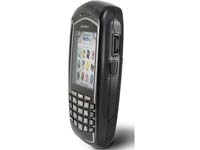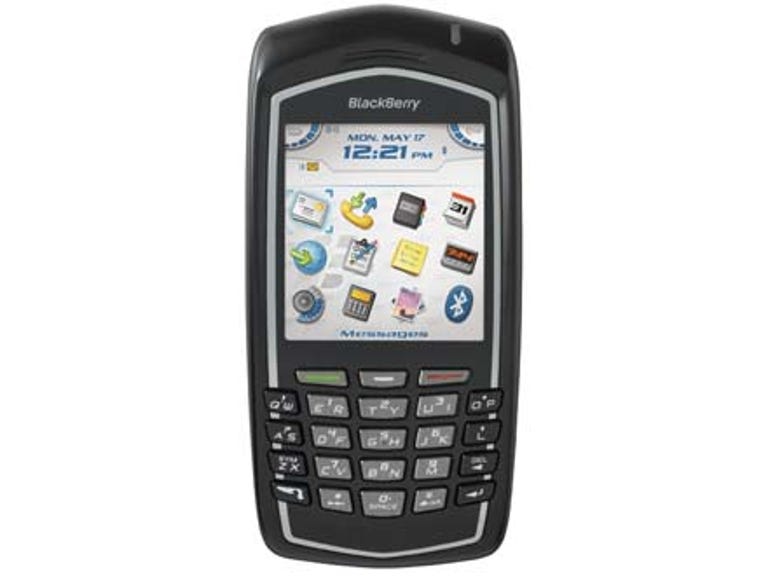 Why You Can Trust CNET
Why You Can Trust CNET BlackBerry 7130e review: BlackBerry 7130e
The BlackBerry 7130e is an expensive undertaking, but if you're a mobile professional the cost is undoubtedly justified.
Design
There are two distinct types of BlackBerry: the data-oriented varieties -- such as the 8700 and the 7250 -- and the phone-oriented models. The former are designed with data entry and avid emailing firmly in mind, and offer a full 35-key QWERTY keyboard. This makes them wider than their phone-like siblings and arguably less suited for use as a mobile phone.
The Good
The Bad
The Bottom Line
On the other hand, the phone-shaped design -- which has been adopted for the 7130e -- is thin and less dorky to hold up to your ear for calls, but emailing is a little more tedious since two letters share each key. Nonetheless, the 7130e is still more than adequate for bashing out short e-mails, thanks to its use of SureType predictive technology.
But make no mistake; while it's certainly not bulky, the 7130e is still larger and heavier than your typical mobile phone. Its dimensions are 55.88 x 22.86 x 116.84 mm (WxDxH) and the unit weighs 130 grams.
 |
Unlike a conventional smart phone or PDA, the BlackBerry's navigation keys are located on the right-hand side of the device. First there's the thumbwheel which is used to traverse the menu system and doubles as an "enter" key when depressed. Just below it is a second button which functions as an "escape" or "back" key. This combination works quite well -- as long as you're right handed. If you operate the device with your left-hand, your middle finger, rather than your thumb, falls on the scroll wheel which can prove uncomfortable.
The power button is located in a familiar spot on the top of the phone, and nearby is a handy LED that flashes red when you've got unread e-mail and green otherwise. The left-hand side offers up a mini-USB port for connection to a PC, as well as a headphone jack.
Features
Of course, the BlackBerry's killer app is always-on e-mail, which corporate users have taken to like fish to water. That said, the BlackBerry is also of use to highly mobile small business users and individuals, as it can access any ISP's POP3 mail server. It supports up to 10 different e-mail accounts, and for the uninitiated, e-mails are automatically passed from the e-mail server to your BlackBerry just like a regular SMS text message. There's no logging in required and messages can be replied to instantaneously.
The device is currently only available through Telstra and operates on its EV-DO network. There are separate plans for enterprise and individual users, but most CNET.com.au readers will be interested in the individual plan. Configuring accounts can be done painlessly through Telstra's Web site, and users can be up and running within minutes.
In addition to its push-email capabilities, the 7130e also supports regular voice calls and SMS. Calling is fairly flexible, as the phone offers both loud speaker support and Bluetooth support for connecting an external headset. There's also a full HTML Web browser, and pages load quickly thanks to Telstra's speedy EV-DO network. Granted, EV-DO doesn't tangibly boost the 7130e's e-mail function, as the BlackBerry converts messages into plain text anyway, thus not requiring much bandwidth.
All content looks sharp on the 240x260, 65,536 colour display, and the backlight makes reading text extremely comfortable. In addition, storage space is ample at 64MB of flash memory and 16MB of SRAM.
An interesting feature found on newer BlackBerry models is Telstra's Mobile Broadband functionality. This enables it to morph into an EV-DO modem for surfing the web from a notebook or desktop PC when connected to the handheld via USB cable. Telstra's EV-DO network can reach speeds of up to 600Kbps in metropolitan areas, but the device reverts to the 100Kbps CDMA network in regional areas.
Unfortunately, the Telstra Connection Manager that's used to enable the Mobile Broadband feature isn't available on PDAs as yet, albeit the BlackBerry offers most of the functions of a PDA anyway. These include a calendar, address book, alarm clock and To-Do list, among others.
If you're not a business user, the BlackBerry probably isn't for you. This is because, aside from being expensive, it also lacks many of the features found on consumer-targeted smart phones such as music/video playback support and an integrated camera.
Performance
We tested the dual-band phone in the Sydney metropolitan area using Telstra's network. Both regular and loud speaker call quality was pleasingly clear, while e-mail delivery was faster than expected, with messages often hitting the handheld before we received them in our inbox at home.
Using the 7130e as a wireless modem, we found the EV-DO network to be extremely speedy, reaching 3G-trumping speeds of just under 500Kbps. This is below the theoretical 600Kbps maximum, but still extremely impressive for a mobile device.
RIM claims that the device's battery will last for three hours of talk time and up to eight days standby time. The claimed standby time was spot on, but talk time actually exceeded the manufacturer's promises by around an hour.
Telstra offers a number of plans for the 7130e, all of which are fairly expensive. Handheld included, customers can begin a 24-month contract and pay AU$89.95 per month for unlimited e-mail. If you can supply your own BlackBerry, this drops to AU$49.95 per month on a 24-month contract or AU$54.95 per month without a contract.
Adding five hours, twenty hours or forty hours of EV-DO modem usage will bring the plan up to AU$99, AU$129 and AU$149 a month respectively, with the handheld included. If you BYO handheld, the prices drop to AU$59, AU$89 and AU$109 respectively. Should you exceed your monthly EV-DO usage, you'll be charged an extra AU$1.50, AU$1 or AU$0.50 per five minute block depending on whether you're on the five, twenty of forty hour plans. The charge for exceeding your monthly EV-DO quota is the same whether you supply your own BlackBerry or not.
Note that the above prices only refer to the e-mail and mobile broadband features of the handheld. You'll have to pay extra if you want regular voice calls as well.
The BlackBerry 7130e is an expensive undertaking, but if you're a mobile professional the cost is undoubtedly justified.
